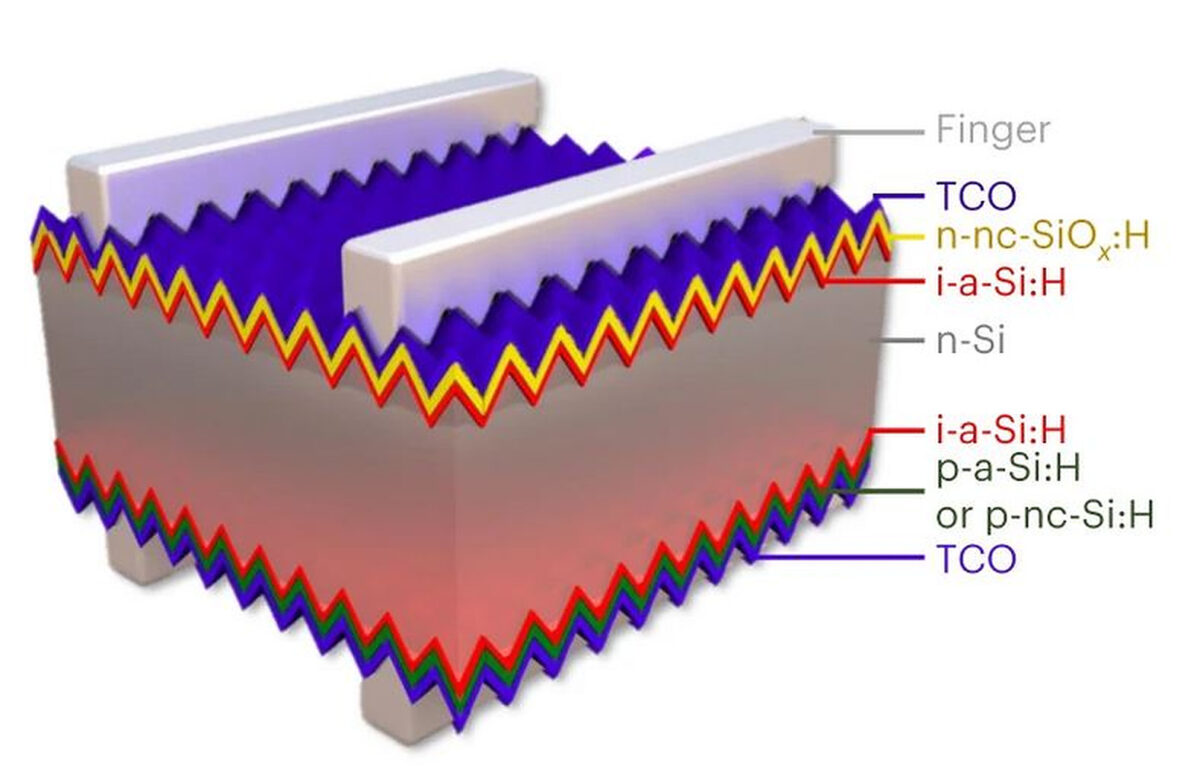From pv magazine Global
In November last year, Chinese module maker Longi announced that an unspecified heterojunction (HJT) solar cell based on a full-size silicon wafer achieved a world record-breaking power conversion efficiency of 26.81% in mass production, claiming the result had been confirmed by Germany’s Institute for Solar Energy Research Hamelin (ISFH).
This result reportedly beat the record achieved by Japanese chemical company Kaneka. Its 180 mm² crystalline silicon device, which featured heterojunction and back-contact technology, achieved 26.63% efficiency.
“We cannot disclose if the cell is n-type or p-type at this stage,” a Longi’s spokesperson told pv magazine at the time. Now, however, an international research group led by Longi Central R&D Institute has decided to present the solar cell in the paper “Silicon heterojunction solar cells with up to 26.81% efficiency achieved by electrically optimised nanocrystalline-silicon hole contact layers,” published in nature energy.
The group built the M6-sized cell with a transparent conductive oxides (TCO) contact, a p-type amorphous silicon hydrogenated (p-nc-Si:H) layer, a nanocrystalline silicon layer, a p-a-Si:H layer, an n-type crystalline silicon absorber, an i-a-Si:H layer, passivating contacts (CSPCs) made of hydrogenated silicon monoxide (SiOx:H), silver (Ag) top electrodes, and an anti-reflective coating based on magnesium fluoride (MgF2).
The device achieved a power conversion efficiency of 26.81%, an open-circuit voltage of 751.4 mV, a short-circuit current of of 41.45 mA cm−2, and a fill factor of 86.07%.
“The implementation of p-nc-Si:H together with matched TCO leads to a dramatic reduction in the contact resistivity at the rear side, resulting in an efficiency increase,” they further explained, noting that this cell configuration also increased the charge carrier transport and a low contact resistivity. “The cells endowed with these electrical improvements easily trigger band-to-band tunnelling (BTBT) transport behaviour and induce a sharp band bending, enhancing hole extraction efficiency.”
The researchers attributed the cell efficiency improvement to the implementation of p-nc-Si:H together with a modified TCO, which they said greatly reduces the cell contact resistivity. “The total series resistance of the solar cell is reduced from the original 0.37 to 0.2 Ω cm2, yielding a record fill factor for a single-junction silicon solar cell,” they stated.
The research team included scientists from the Delft University of Technology, which recently developed new passivating contacts (CSPCs) made of polysilicon and silicon monoxide (poly-SiOx) and the Sun Yat-sen University in China, which recently built a perovskite solar cell based on a nitrogen-doped titanium oxide (TiOxNy) electron transport layer that achieved a record fill factor.
In September, Longi said it had achieved an efficiency of 26.12% for a gallium-doped, p-type heterojunction (HJT) solar cell based on an M6 wafer. The company also achieved an efficiency of 25.47% for the same solar cell in March.
In addition, the Chinese manufacturer recorded an efficiency of 26.5% for an n-type HJT solar cell in June and a 25.19% rating for its p-type TOPCon solar cell in July 2021. In June 2021, it achieved a 25.21% efficiency rating for an n-type TOPCon PV cell.
This content is protected by copyright and may not be reused. If you want to cooperate with us and would like to reuse some of our content, please contact: editors@pv-magazine.com.









By submitting this form you agree to pv magazine using your data for the purposes of publishing your comment.
Your personal data will only be disclosed or otherwise transmitted to third parties for the purposes of spam filtering or if this is necessary for technical maintenance of the website. Any other transfer to third parties will not take place unless this is justified on the basis of applicable data protection regulations or if pv magazine is legally obliged to do so.
You may revoke this consent at any time with effect for the future, in which case your personal data will be deleted immediately. Otherwise, your data will be deleted if pv magazine has processed your request or the purpose of data storage is fulfilled.
Further information on data privacy can be found in our Data Protection Policy.